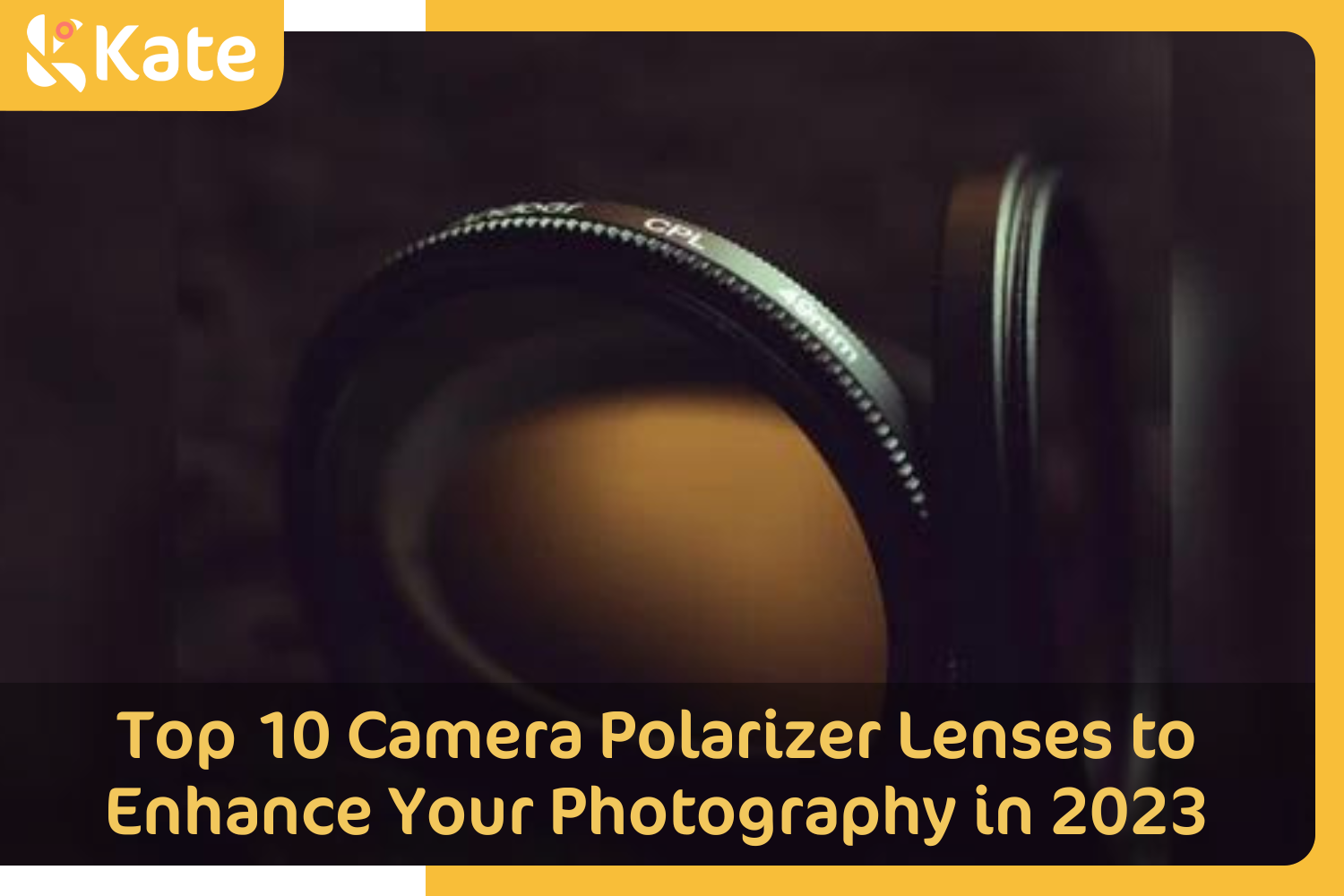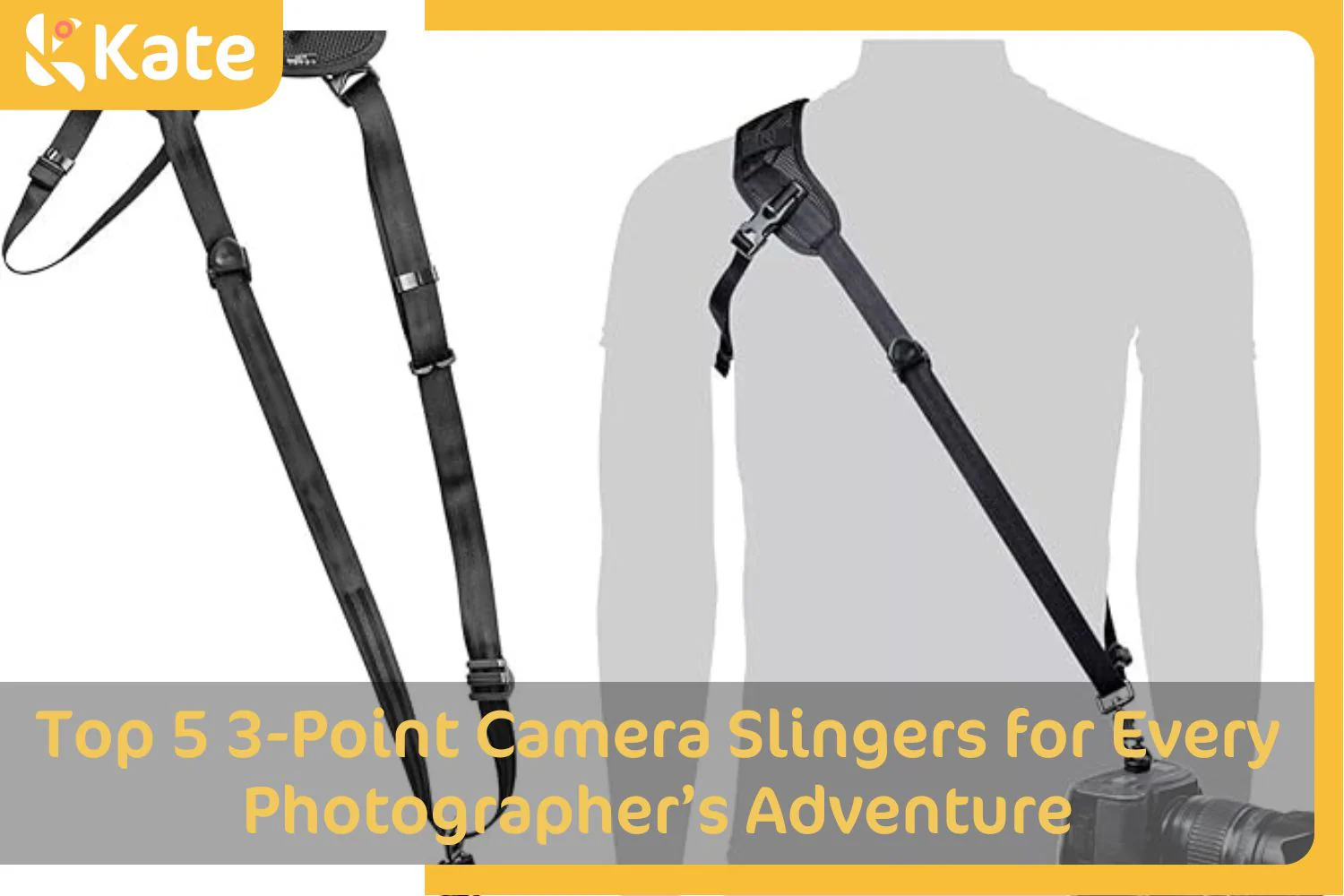Top 10 Camera Polarizer Lenses om je fotografie in 2023 te verbeteren Designed by Kate

Verbeter je fotografie met een camera polarizerlens. Deze filters verminderen reflecties, schittering en verbeteren de kleurverzadiging en het contrast. Onze koopgids helpt je de beste camera polarizerlens te kiezen voor jouw behoeften. Ontdek belangrijke factoren om te overwegen en top productaanbevelingen.
Twee Typen Camera Polarizerlens
1. Circulaire Polarizerfilter

Afbeeldingscredits: amazon.com
Circulaire polarizerlensfilters zijn geweldig voor alle DSLR-camera's, maar lineaire zijn dat niet. Ze bieden meer veelzijdigheid in wat je kunt doen en hoe dingen eruit zien. Hoewel het ook gevoelig is voor lineair gepolariseerd licht, laat het cirkelvormig gepolariseerde lichtgolven door de lens stromen.
Een kwartgolfplaat, een extra stuk glas, wordt achter een lineaire polarizer in een circulaire polarizerfilter geplaatst, waardoor licht in een cirkelvormig patroon kan worden gepolariseerd.
2. Lineaire Polarizerfilter
Afbeeldingscredits: amazon.com
Er is maar één polarisatielaag in lineaire polarizerfilters. De spiegels in DSLR-camera's kunnen ervoor zorgen dat lichtstralen kruisgepolariseerd raken nadat ze erdoorheen zijn gegaan, wat interferentie veroorzaakt met de meet- en autofocustechnologieën.
Voordelen van het Gebruik van een Polarizerfilter voor Camera Lenzen
1. Helpt bij nauwkeurige metingen.
Wanneer je foto's maakt onder heldere omstandigheden, kan het meetsysteem in je digitale camera worden misleid door schittering en reflecties, wat resulteert in onderbelichte beelden.
2. Vermindert vignettering.
Vignettering treedt op wanneer de hoeken van een afbeelding donkerder lijken dan het midden. Door de hoeveelheid licht die je lens binnenkomt te verminderen, kan een polarizerlensfilter helpen om vignettering te minimaliseren en schoner uitziende afbeeldingen te produceren.
3. Verhoogt kleurverzadiging.
Het polarizatie-effect helpt de hoeveelheid gereflecteerd licht te verminderen, waardoor de kleuren in de scène levendiger en verzadigder lijken. Dit kan vooral nuttig zijn bij het fotograferen van landschappen of andere buitenscènes.
4. Voordeel voor autofocusfotografie.
Polarizerfilters kunnen helpen de hoeveelheid gereflecteerd licht te verminderen die autofocus-sensoren moeten overwegen.
5. Maak het mogelijk om langzamere sluitertijden te gebruiken voor watershots.
Wanneer je waterfoto's maakt, zoals foto's van watervallen, moet je misschien een langzamere sluitertijd gebruiken zonder de afbeelding over te belichten. Dit is mogelijk met een polarizerfilter dat minder lichttransmissie naar de camera toelaat.
6. Vermindert reflectie wanneer water betrokken is.
Wanneer je foto's maakt van reflecterende oppervlakken, zoals water of metalen oppervlakken, is het belangrijk om de hoeveelheid licht die in de cameralenzen wordt gereflecteerd te verminderen. Dit kan worden gedaan met een polarizer camera lensfilter, dat helpt om wat licht te absorberen en reflecties te verminderen. Als gevolg hiervan zullen foto's die met een polarizerfilter zijn genomen minder schittering hebben en gelijkmatiger verlicht zijn.
7. Versterkt kleur door haze te elimineren.
De hoeveelheid licht die van oppervlakken weerkaatst op een heldere, zonnige dag kan overweldigend zijn. Maar door een polarizer effect op je camer lens te gebruiken, kun je schittering en reflecties drastisch verminderen en de ware kleuren van de scène naar voren brengen. Het resultaat zijn levendige blauwe luchten en scherpere details.
8. Pas de donkerte van de lucht aan voor een beter effect.
Naast het versterken van kleuren, kan een polarizerfilter ook worden gebruikt om de lucht donkerder te maken voor een meer dramatisch effect, of het filter draaien voor een gelijkmatigere lucht wanneer dat nodig is. Dus of je nu een kleuraccent aan je foto's wilt toevoegen of verbluffende landschappen wilt creëren, een polarizerfilter is een must-have voor elke fotograaf.

Foto door William Bayreuther op Unsplash
Hoe een Camera Polarizerlens Kiezen
1. Het Merk
Camera polarizerfilters zijn niet allemaal gelijkwaardig. Er kunnen aanzienlijke kwaliteitsverschillen tussen merken zijn, dus het is belangrijk om wijs te kiezen bij het selecteren van een camerafilter voor jouw camera.
Enkele voorbeelden van merken die camera polarizerlenzen maken zijn Lee, Hoya en Heliopan. Elk merk heeft zijn sterke en zwakke punten, dus het is belangrijk om onderzoek te doen om te achterhalen welke voor jou geschikt is.
2. Budget
Camera polarizerfilters kunnen variëren in prijs van ongeveer $20 tot meer dan $100, dus het is belangrijk om te bepalen hoeveel je bereid bent uit te geven voordat je een aankoop doet.
Als je een strak budget hebt, is het waarschijnlijk het beste om bij een goedkopere optie te blijven. Maar als je bereid bent om iets meer geld uit te geven, kun je waarschijnlijk een hogerwaardig filter vinden.
3. Diameter
Camera polarizerfilters zijn beschikbaar in verschillende maten, dus het is belangrijk om er een te kiezen die de juiste maat voor jouw camerahoesje heeft. De meest voorkomende maten zijn 50mm, 58mm en 65mm. Als je niet zeker weet welke maat lenzenfilter je nodig hebt, kun je deze informatie meestal vinden door je digitale cameramodel online op te zoeken.
4. Dikte
Als het gaat om polarizerlenzen, is de dikte een belangrijke overweging. Een dikkere lens blokkeert meer licht, wat resulteert in een donkerder foto. Het biedt echter ook betere polarizatie, waardoor reflectie en meer verzadigde kleuren worden verminderd.
Daarentegen laten dunnere lenzen meer licht door, wat resulteert in een helderdere foto in omstandigheden met weinig licht. Ze bieden echter ook minder polarizatie, wat resulteert in meer schittering en minder verzadigde kleuren.
5. Type
Camera polarizerfilters zijn verkrijgbaar in twee verschillende types: lineair en cirkelvormig. Lineaire filters zijn goedkoper, maar kunnen problemen veroorzaken met autofocus en metingen. Circulaire polarizerlensfilters zijn daarentegen duurder maar hebben deze problemen niet.
10 Beste Camera Polarizerfilters in 2023
1. Urth Circulaire Polarizer

Afbeeldingscredits: amazon.com
Specificaties
- Draaddiameter bereik: 37mm-95mm
- Dikte: niet gespecificeerd
- Coatingbeschrijving: Nano coating
- Foto filter effecttype:
- Waterbestendigheidsniveau: Polarizer
Voordelen
- Zeer betaalbaar
- Werkt soepel
- Goede glazen polarizer
Nadelen
- De lens is niet helder
- Beïnvloedt de autofocus
2. Nikon 82 Circulaire Polarizer
Afbeeldingscredits: amazon.com
Specificaties
- Draaddiameter bereik: geen
- Dikte: niet gespecificeerd
- Coatingbeschrijving
- Foto filter effecttype
- Waterbestendigheidsniveau
Voordelen
- Eenvoudig te installeren en verwijderen
- Vrij van vervormingen
- Heeft een soepele beweging bij het aanpassen van de intensiteit
Nadeel
- Duur
3. Tiffen Circulaire Polarizerfilter
Afbeeldingscredits: amazon.com
Specificaties
- Draaddiameter bereik:46mm- 82mm
- Dikte: 1.6mm-3mm
- Coatingbeschrijving: Multi-coating
- Foto filter effecttype: kleurcorrectie, Polarizer
- Waterbestendigheidsniveau: Water resistant
Voordelen
- Geweldig voor waterval foto's
- De beeldkwaliteit is mooi en scherp
Nadeel
- Zwakke polarizatie in het filter
4. Cokin NX CPL Filter
Afbeeldingscredits: amazon.com
Specificaties
- Draaddiameter bereik: geen
- Dikte: Niet gespecificeerd
- Coatingbeschrijving: Multi-coating
- Foto filter effecttype: Polarizer, Circulaire Polarizer
- Waterbestendigheidsniveau: Geen
Voordeel
- Geschikt voor groothoeklenzen
Nadeel
- Werkt met Cokin Nx serie
5. Coking P- Serie
Afbeeldingscredits: amazon.com
Specificaties
- Draaddiameter bereik:48mm-82mm
- Dikte:1.6mm-3mm
- Coatingbeschrijving: Geen coating
- Foto filter effecttype: Circulaire Polarizer
- Waterbestendigheidsniveau: Geen
Voordelen
- Gemakkelijk te gebruiken
- Hoge kwaliteitsafbeelding
-
Het heeft een geweldige glazen constructie
Nadeel
- Rotates niet gemakkelijk in de filterhouder
6. Hama Circulaire Polarizer
Afbeeldingscredits: amazon.com
Specificaties
- Draaddiameter bereik:37mm-82mm
- Dikte:6mm
- Coatingbeschrijving: Multi-coating
- Foto filter effecttype: Ultraviolet, circulaire Polarizer
- Waterbestendigheidsniveau: Geen
Voordelen
- Hoge kwaliteit constructie
- Gemakkelijk aan te passen
Nadelen
- Je kunt geen lenskap gebruiken
- Kan worden losgeschroefd
7. B+W Circulaire Polarizer Kaesemann
Afbeeldingscredits: amazon.com
Specificaties
- Draaddiameter bereik:30.5mm-112mm
- Dikte:4.5mm
- Coatingbeschrijving: Multicoating
- Foto filter effecttype: circulaire Polarizer
- Waterbestendigheidsniveau: Water resistent
Voordelen
- Het heeft een uitstekende glas
- Gemakkelijk aan te brengen en te verwijderen van de lens
Nadeel
- Draait niet gemakkelijk
8. Lee Elements Circulaire Polarizerfilter
Afbeeldingscredits: amazon.com
Specificaties
- Draaddiameter bereik:67mm-82mm
- Dikte: niet gespecificeerd
- Coatingbeschrijving: Multi-layer coating
- Foto filter effecttype: Versterkend, Polarizer, Circulaire Polarizer
- Waterbestendigheidsniveau: Geen
Voordelen
- Uitstekende optische prestaties
- Wordt geleverd in een beschermende case rigide doos
Nadeel
- Duur
9. Lee 100 Polarizer
Afbeeldingscredits: amazon.com
Specificaties
- Draaddiameter bereik: 49mm-105mm
- Dikte:2mm
- Coatingbeschrijving:geen
- Foto filter effecttype: Circulaire
- Waterbestendigheidsniveau: Water resistent
Voordelen
- Uitzonderlijke optische kwaliteit
- Voelt goed aan als het in positie wordt geplaatst
Nadeel
- Moet moeilijk te verwijderen zijn
10. Marumi DHG Circulaire Polarizer
Afbeeldingscredits: amazon.com
Specificaties
- Draaddiameter bereik:37mm-105mm
- Dikte:5mm
- Coatingbeschrijving: Multi-coating
- Foto filter effecttype: Polarizer, Circulaire Polarizer
- Waterbestendigheidsniveau: water- en olieafstotende coating
Voordelen
- Betaalbaar
- Het is goed geconstrueerd
Nadeel
- Moet moeilijk te draaien zijn
Bonus Tips:
Polarizerfilters zijn een geweldige investering voor elke fotograaf, maar er zijn een paar dingen om in gedachten te houden om het meeste uit je aankoop te halen.
1. Haalt het meeste uit je dure polarizerfilter
Als landschapsfotograaf weet je dat investeren in een polarizerfilter altijd een goed idee is. Het helpt je om geweldige landschapsfoto's vast te leggen en verbetert de kleurverzadiging in de luchten en andere heldere gebieden van een foto. Maar wist je dat er een paar manieren zijn om het meeste uit je dure polarizerfilter te halen?
Het gebruik van een stap-up ring maakt het mogelijk om je polarizerfilter te gebruiken op lenzen van verschillende diameters. Dit is handig als je een verscheidenheid aan lenzen hebt en niet meerdere filters wilt kopen. Bovendien beschermt het gebruik van een stap-up ring je filter tegen krassen en vuil.
Vergeet niet dat polarizerfilters de hoeveelheid licht die je sensor bereikt kunnen verminderen, dus het kiezen van een filter met een multi-coating is belangrijk om dit effect te minimaliseren.
2. Pakt onnatuurlijk donkere lucht aan
Bij het maken van foto's van de lucht kun je een onnatuurlijk uitziende donkere lucht tegenkomen. Dit komt doordat de blauwe lucht wordt veroorzaakt door gepolariseerde lichtgolven, en wanneer je een polarizerfilter gebruikt, blokkeert het enkele van deze lichtgolven.

Foto door Yann Allegre op Unsplash
Wat kun je doen om dit te verhelpen? Als je een verstelbaar polarizerfilter hebt, kun je het polariserende effect verminderen door het filter te draaien. Dit zal helpen om de lucht er natuurlijker uit te laten zien en de algehele foto te verbeteren.
3. Versterk stadsfoto's zelfs vanuit een raam
Polarizerfilters zijn een van de meest populaire filters die door fotografen worden gebruikt, vooral door degenen die stads- of architectuurfoto's maken. Ze werken door de hoeveelheid reflecterend licht die de camer lens binnenkomt te verminderen. Dit resulteert in een scherpere afbeelding, verhoogd contrast en meer verzadigde kleuren.
Polarizers zijn vooral effectief bij het fotograferen door glas, zoals ramen. Het glas weerkaatst vaak veel licht, wat kan leiden tot een vervaagde afbeelding. Door een polarizer te gebruiken, kan de fotograaf de hoeveelheid gereflecteerd licht verminderen en een veel scherpere, levendigere afbeelding produceren.
Polarizers kunnen ook worden gebruikt om de hoeveelheid schittering op water of andere glanzende oppervlakken te verminderen. Dit kan nuttig zijn bij het fotograferen van stadsfoto's die veel gebouwen met reflecterend glas bevatten. Door een polarizer te gebruiken, kan de fotograaf de schittering elimineren en een meer gelijkmatig verlichte afbeelding produceren.
Conclusie
Camera polarizing filters kunnen een geweldige manier zijn om de kwaliteit van je foto's te verbeteren. Het is echter belangrijk om het juiste filter voor jouw behoeften te kiezen. Overweeg prijs, diameter, dikte en type vóór je een aankoop doet.
Als je niet zeker weet welk filter geschikt voor je is, raadpleeg dan zeker een professional. Met wat onderzoek vind je ongetwijfeld het perfecte camera polarizerfilter voor jouw behoeften.
Als je dit artikel leuk vindt, deel het dan! Vergeet niet om lid te worden van onze FB-groep: https://www.facebook.com/groups/Katebackdrops/ om je ideeën te delen! Je kunt ook gratis artikelen, updates en kortingsinformatie ontvangen van https://www.katebackdrop.com/ en onze FB-groep.







 Boogschutter
Boogschutter













